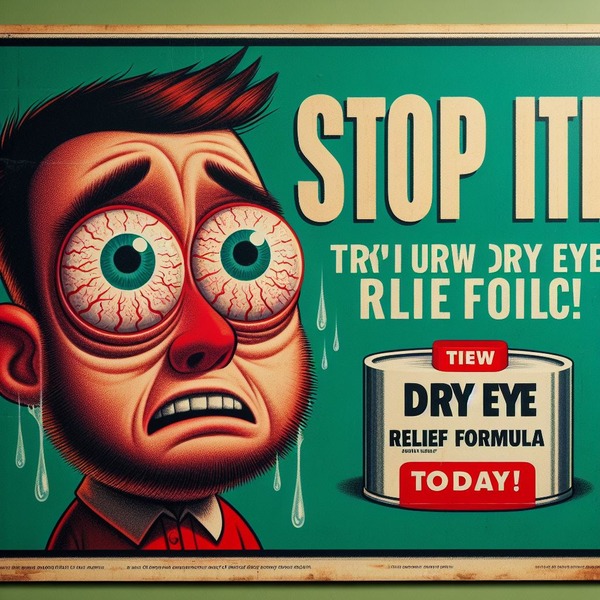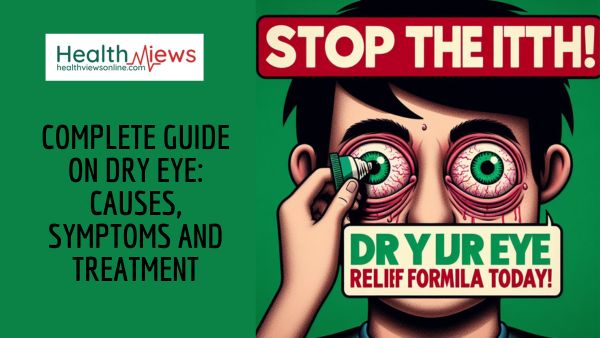What is Dry Eye?
Dry eyes are caused by a problem with your tear film, which is made up of three layers of tears that cover and protect the surface of your eyes. It happens when the eyes produce too few tears or when the tears evaporate too quickly. The disease can affect one or both eyes. Lifestyle changes can help, but in severe cases, a person may require medication or surgery.
Dry eyes are uncomfortable. Your eyes may sting or burn if you have dry eyes. Dry eyes can occur in a variety of scenarios, including flying, being in an air-conditioned room, riding a bike, or staring at a computer screen for several hours.
Also, Read Complete Information about Cataracts: Causes, Symptoms and Treatment

Causes
Hormonal changes cause people to cry less often as they age. Dry eyes can affect both men and women. Nonetheless, women are more likely to experience it—particularly those who have gone through menopause.
Other causes of dry eyes include the following:
- Certain diseases, like rheumatoid arthritis, Sjögren’s syndrome, thyroid disease, and lupus
- Blepharitis (inflammation or redness of the eyelids)
- Entropion (when the eyelids turn inward); ectropion (when the eyelids turn outward)
- Being in smoke, wind, or a very dry environment
- Hours of computer use, reading, and other activities that diminish blinking
- Long-term use of contact lenses
- LASIK or other refractive eye surgery
Taking specific medications, such as:
- High blood pressure diuretics (water tablets)
- Beta-blockers, for hypertension or heart conditions
- Allergy and cold medicines (antihistamines)
- Sleeping tablets
- Antidepressant and anxiety medications
- Medications for heartburn
Symptoms
The following signs and symptoms, which usually involve both eyes, may occur:
- The feeling of stinging, burning, or scratchiness in the eyes
- Stringy mucus in or around your eyes
- Sensitivity to light
- Eye redness
- A feeling that something is in your eyes
- Difficulty wearing contact lenses
- Difficulty driving at night
- Watery eyes are the body’s reaction to dry eye discomfort.
- Eye strain or blurred vision
Risk factors
Factors that increase your chances of having dry eyes include:
- Tear production tends to decline as you become older. Dry eyes are more common in adults over the age of 50.
- A lack of tears is more common in women, especially if they are going through hormonal changes such as pregnancy, using birth control pills, or going through menopause.
- Eating a diet deficient in vitamin A (found in liver, carrots, and broccoli) or omega-3 fatty acids (found in fish, walnuts, and vegetable oils).
- Wearing contact lenses or having had refractive surgery in the past.
Diagnosis
Dry eye is diagnosed by your healthcare professional based on your medical history, an eye exam, and tests. Tests include:
- Slit lamp exam: This test measures the amount of tears produced by your eyes. The provider puts a light into each of your eyes and examines your eyes and eyelids with a microscope.
- Schirmer’s test: Another method for determining tear generation. A little piece of paper is placed along the edge of your eyelid by the provider and left there for many minutes.
- Tear breakup time (TBUT) test: This test determines how soon your tears disappear. A dye is injected into your eye, and a microscope is used to determine how long your tear film remains stable (doesn’t break apart).
Treatment
Treatment may include one or more of the following methods, depending on the cause of the dry eye:
- Adding tears – OTC artificial tears can commonly be used to treat mild situations of dry eye.
- Conserving tears – This approach aims to maintain tears within the eye for a longer period to prevent dry eyes. This can include obstructing the tear ducts, which drain tears from the eyes.
- Increasing tear production – Tear production can be increased by using eye drops prescribed by a doctor. If you have severe or persistent dry eyes, you may need to take oral cyclosporine (Restasis, Cequa) or lifitegrast (Xiidra).
- Treating underlying causes
Diet
A lack of vitamin A or Omega 3 fatty acids can raise the risk of having dry eyes. Source
Sources of vitamin A include:
- oily fish
- eggs
- cheese
- milk and yogurt
- red vegetables
- green leafy vegetables
Sources of omega 3 include:
- oily fish
- seafood
- flax seed
- soybeans
- canola oil
Prevention
- Blinking often while reading or looking at a computer screen for long periods.
- When going outside, wear sunglasses with wraparound frames to defend against climatic reasons of dry eye.
- Avoiding dry outdoor conditions.
- Using a humidifier at work and at home to boost indoor humidity.
- Avoiding dehydration by drinking enough water.
- Consultation with a doctor regarding dry eye supplements.
Also, Read Complete Information about Amblyopia (Lazy Eye): Causes, Symptoms and Treatment





